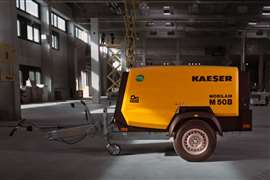Dublin design - Steve Skinner reports on the widening of the M50 motorway
15 February 2010

Widening Ireland's busiest motorway has proved to be an inspiration for the Atkins design and engineering consultancy. Steve Skinner reports from Dublin on some innovative ideas to keep traffic flowing.
The widening of the M50 motorway around Dublin in Ireland represents the country's largest infrastructure project and, once completed, will benefit 100000 vehicles each day. Construction associated with the multi-contract project started in February 2008 and is scheduled to be completed in October 2010.
Contracts One and Three covering an 11 km section between the N3 and N4 interchanges were completed in 2008 while construction of Contract Two, which involves the widening of 23 km of motorway and the upgrading of seven interchanges, started in February 2008 and is scheduled for completion in October 2010.
Contract Two, valued at € 250 million, is geographically split in two, with construction taking place to the north of the capital between junctions 3 and 6 and to the south between junctions 14 and 11.
The Contract was awarded by the National Roads Authority (NRA) as a Public Private Partnership (PPP) contract with a 35 year concession to M50 Concession Limited, a joint venture headed by Spain's Globalvia and SyV Group with local representation from PJ Hegarty.
For the design + construct contract this company appointed M50 (D&C) Limited, a Spanish led consortium comprising FCC and Sacyr with PJ Hegarty.
M50 (D&C) Limited awarded the design contract to Atkins which revisited initial NRA approved plans and suggested fundamental alterations to enhance traffic flow and simplify construction.
Interchanges
Atkins project manager, Richard Neuling told CE, "For us the key has been in the design of the interchanges and in particular Junction 6 where the M50 and N3 meet at Blanchardstown. The original plans for the junction were highly complex and involved tunnelling under railway lines and the Royal Canal, which represented a series of significant construction problems.
"In conjunction with M50 (D&C) Limited, we reviewed this junction and created a substantially different profile incorporating a five-span viaduct that eliminated the need for any tunnelling. This alternative scheme required a new environmental impact statement (EIS).
"This represented a real risk for the consortium, as there were no guarantees the EIS would be approved , but they were prepared to wait in the knowledge that approval would lead to the construction of a much more efficient junction that would offer huge cost and time savings.
"Indeed, with approval granted, the project has already caught up on the original schedule even with the nine month delay," said Mr Neuling.
A key aspect in speeding up construction of the 21 bridges on the scheme has been the adoption of a newly designed steel section 3 m long pre-cast cantilever section for bridge construction that bolts in place and does away with the need for falsework and formwork.
Mr Neuling told CE, "This cantilever system has helped significantly with traffic management and saved costs for the contractors. We've been able to save up to eight weeks in the construction of each bridge as a result and it's certainly a design that we'll use again in the future."
Shay Murtagh Precast supplied the 48000 m3 of concrete for all 21 bridges and the viaduct using two Belgian Damman-Croes planetary mixers producing up to 60 m3 per hour.
As well as reconfiguring Junction 6, Atkins upgraded the design for Junction 1 where the M50 meets the M1.
"We increased the size massively to improve traffic flow," said Mr Neuling. "The new interchange features a steel bridge that has been constructed using four 160 tonne beams, which were lifted into place overnight. This junction is another example where we were able to limit the impact of construction on traffic by using pre-fabricated components," he said.
At the M50/N2 junction 5, Atkins added two bridges to the original design in order to create a junction that flowed more freely. Mr Neuling told CE, "Although this added cost for the contractors, it makes for a more free-flowing junction, which was a key NRA requirement.
"Indeed, M50 (D&C) Limited were able to negotiate extra funding from the NRA for providing a more efficient interchange design."
Payment for the concession will be made by the Irish government on the basis of lanes being kept open rather than tolling, so it was imperative that Atkins designed junctions that flowed freely.
Widening
Beyond the interchanges, the project also involves the widening of 23 km of motorway to three lanes in the south and four in the north. This aspect has been aided by the original motorway design, constructed in the early 1990s, which featured a 15 m wide central reservation.
"The original design has made widening easier because we didn't need to take land from the outside," said Mr Neuling. "Also, bar one, we didn't have to widen any bridges and we've been able to keep the hard shoulders in place. The foresight shown in construction of the original M50 has certainly paid dividends now," he said.
The sheer scale of the project is most starkly defined by the volume of equipment. Kevin McHugh from Shannon Valley Hire told CE, "We have over 60 excavators on site, the majority of which are Hitachi, which are being used for excavations and placing, site clearance, the installation of drainage and stripping of top soil. We are also supplying dump trucks, dozers and compactors.
"This project has been highly pressurised and involved major planning and logistics in order to meet deadlines as work has progressed," he told CE. "For us, providing so much equipment has been a major achievement."
Complicated
Widening of the M50 has necessitated a fine balance between traffic management, speed of construction and innovative designs to aid traffic flow. As Mr Neuling told CE, "This is a most complicated road project, much more so than the widening of the M25 London orbital across in the UK because of the complexity of the work at the interchanges."






